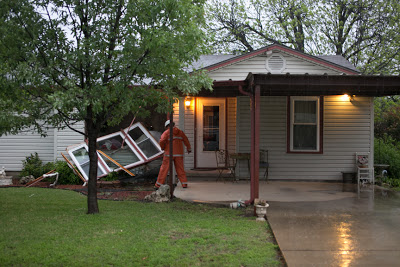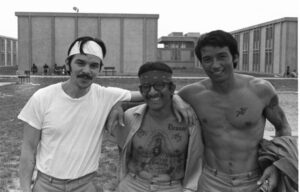Corporate Crime Scene in West, Texas photo essay
Anne Lewis with photographer Patrick Bresnan published April 3, 2013 on the Rag Bog.
AUSTIN — This is about the fertilizer explosion in West, Texas, on the night of April 17, 2013. It’s also about Patrick Bresnan who found himself in West on the night of the explosion and his photographs in the aftermath of the tragedy.
Governor Perry called it a crime scene; the progressive community says, yes, corporate crime. Neither the paranoid fantasy of Governor Perry who is stuck in an ideology that says that companies can do no wrong, nor the abstract politics of progressives blaming the state’s lack of regulation — “We shouldn’t produce fertilizer anyway because it’s not good for the planet,” I overheard in a coffee shop — seem to get at any real truth.
I ask myself the question: how one can be kind and dignified in the face of such sorrow and loss? I try to collect myself and cannot help but think about the Central Appalachian coalfields.
The dangers of coal mining both for the environment and the workers permeated my senses. I was married to an underground coal miner. I knew not to have an argument before he went to work. He might not come back. And we would patch things up, even when we shouldn’t have.
Time slowed in the hour that I expected him to come home. The most intimate relationship was distorted by the fear of injury and death. Then Rocky Peck, a young miner with a wife and daughter who wrote the song that ended my film about the Massey strike, was killed in a non-union mine three years after the strike was lost and the film was completed.
I saw raw footage of mining disasters — family members waiting for loved ones who would not come out alive, calling to God for comfort, the exhausted children. I heard statements of attempted compassion by local mine managers who opened their offices to suffering families but protected the absent company, denying information and economic aid and never accepting guilt by apologizing.
I remember an eloquent piece by Michael Kline, a radio story with Sarah Koznoski who lost her husband in the Mannington, West Virginia, mine explosion in 1968. Seventy-eight men were buried alive. Michael asked Sarah to describe every moment of the last day with her husband.
That was all. There was no mention of Consolidation Coal Company, still the largest underground mining company in the U.S., or the corrupt United Mine Workers union that said Consolidation was a safe company after the explosion, or the lack of regulation or protection by the government. There was just Sarah’s voice describing an ordinary day with her husband. And it was enough.
Then came the rage. “They didn’t want us to know what was going on in their damn dirty filthy mines,” another of the widows would tell us five years later. Those seven widows, who refused the $10,000 death money from Consolidation Coal Company, organized a response across the coalfields. Coalminers and their communities rose up from the grassroots. They reclaimed their union for the rank and file, and they forced the new laws and regulations that have saved countless lives.
 |
| Field of first response. Triage area, West, Texas. Wednesday, April 17, 2013. Photo by Patrick Bresnan/ The Rag Blog. |
We have heard none of these things from West — none of the deep sorrow, none of the purposeful rage, no clear expression of collective purpose — that this will never happen to other people in another community, especially not to those most loved in any community — the firefighters and first responders. Perhaps it’s just too soon.
Patrick’s experience in West began the warm evening of the explosion. A European film director had wanted to document the last day of life of a young black man who was next on the Texas execution list. Patrick traveled to Waco to locate the man’s family and ask them to participate in the film. He was using the Internet at Starbucks when he saw a steady stream of ambulances and heard about a huge explosion in a nearby town. He drove to West.
There he found himself stalled in a traffic jam filled with ambulances, emergency responders, police, firefighters, people who had come from as far away as three hundred miles to help. A call had gone out to bring needed wheelchairs to the community center and community people waited to get through, wheelchairs in the backs of pickups.
Some tried to reach relatives in the community center but only the injured and the elderly were allowed in. Patrick described the smell of heavy chemicals and urine. 133 patients had been evacuated from the West Rest Haven Nursing Home and there was no way to help them use the bathroom.
He decided to see if he could get pictures of the fire and drove to the part of town that had been evacuated. He began to walk towards the fire but the air was hot. It was windy and so heavy with chemicals that he was forced to turn around. Patrick returned to his truck, took off his shirt, and went to sleep.
Wednesday morning was cold and rainy. By the time Patrick got back to the community center, most of the firefighters had left. Then a mass of new people descended on the town — roaming the streets, doing their makeup and practicing their lines out loud, “Live from West, Texas — a town that will never be the same. This small tightly-knit community,” over and over. Anderson Cooper popped up and Patrick succumbed like many others and took a photograph of himself with Cooper.
 |
| Succumbing to the celebrity presence! Photographer Bresnan takes his own picture with CNN’s Anderson Cooper. Photo by Patrick Bresnan / The Rag Blog. |
Patrick didn’t see reporters doing any kind of research or having serious interviews with local people. They were in West to do their makeup and read a few contrived lines to the camera. At the West Cattle Auction the media appeared to him like a group of animals. Patrick returned a week later to take a few additional pictures and attend the memorial. He told me of a Catholic priest who spoke from the heart about what had happened, but nobody mentioned the fertilizer plant.
At about that time I was on a shuttle bus at the Austin airport coming home from a weekend trip. The Latina shuttle bus driver announced, “Welcome home.” A woman on the bus said that she had no home to return to, that she lived in West. She pulled out a newspaper with before-and-after pictures and pointed to her house which was within the 1,500 foot blast perimeter. She had been at a far off hospital visiting her son who had been shot in Afghanistan when the explosion occurred.
When another woman on the bus asked if the plant was old and dilapidated, the woman said she really didn’t remember. It had always been there. She was just glad that her family had survived. She would go home to look for her missing cat. As she got off the shuttle bus, the driver gave her a big hug and handed her all of her tip money. She said, “Take it” and the woman did.
How do we avoid the news story framework that gives us nothing but heroes and victims when tragedy strikes? How can those narratives, as seductive as they may be, possibly move us towards an honest search for the truth? The patriotic frenzy, the flag waving, the church going and singing of popular songs don’t come close to the pictures of mine disasters that stay in my mind’s eye. Patrick’s pictures, as scattered and spontaneous as they may be, seem to get closer to the truth than endless newspaper images of worship and sorrow.
 |
| Media gathered at the West Auction House, West, Texas, Thursday, April 18, 2013. Photo by Patrick Bresnan / The Rag Blog. |
Thirteen people worked at the fertilizer plant in West, but we have heard nothing about them. The news talks about a close-knit community with few jobs, but I’m quite sure that many more livelihoods and lives were damaged at the nursing home, apartment complex, and three damaged schools.
Why didn’t the workers at the fertilizer plant complain about the danger they experienced every day at work and the potential disaster that their work imposed on the community? Was it alienation from their own lives, a lack of power over their own safety, a misplaced loyalty or belief in the power of a supposedly benevolent boss?
The plant had 250 tons of ammonium nitrate on site last year — that’s more than a thousand times the trigger limit for oversight. That deadly factory somehow remained invisible to those who might have intervened.
What about the farmers in this “close knit community”? Surely they were aware of the dangers of the product they purchased and the conditions of its manufacture. Then there’s the religious factory owner who, we read, purchased the plant as an economic contribution to the community. Patrick couldn’t help but compare him to the young man on death row who was the cause of his trip to Waco. That man killed one security guard in comparison to the deaths of 14 people and more than a hundred injured including a child who was playing on a nearby playground when the blast blew him four feet in the air and broke his ribs.
The factory owner hired a Dallas public relations firm to represent him as he opened the doors of his church for the mourning residents of West and spoke through an outside source of his own broken heart.
A coal mine manager once said in one of my films, “If what we are doing in eastern Kentucky is wrong, then the whole country is wrong.” One could say the same about the murderous explosion in West, Texas. There’s something very rotten in our mistaken loyalties to companies over neighbors, our dependence on paternalism for our safety, our willed ignorance, the sacrifices we make to the dollar. Ultimately we all share some part of responsibility for what happened in West, Texas.
I think about the power of transformation, knowing that it must come from rage, knowledge, and love. I believe that deep within the community of West and our own, an independent, courageous, and collective voice can emerge to shake the foundations of what must change.
[Anne Lewis, a senior lecturer at the University of Texas and a member of TSEU-CWA Local 6186 and NABET-CWA, is an independent filmmaker associated with Appalshop. She is co-director of Anne Braden: Southern Patriot, associate director of Harlan County, U.S.A, and the producer/director of Fast Food Women, To Save the Land and People,Morristown: in the air and sun, and a number of other social issue and cultural documentaries. Her website is annelewis.org. Read more articles by and about Anne Lewis at The Rag Blog.]
Some of the photos accompanying this article were also published, under the name Otis Ike, in a gallery at the Austin Chronicle.
 |
| The next morning. House in West, Texas, Thursday, April 8, 2013. Photos by Patrick Bresnan / The Rag Blog. |
 |
| School in West, Texas, Thursday, April 23, 2013. |
 |
| Evacuation area, Thursday, April 18, 2013. |
 |
| Missing dog sign. Thursday, April 23, 2013. |
 |
| Car and flag. Thursday, April 23, 2013. |
 |
| Residents respond to call for wheelchairs. Wednesday, April 17, 2013. |
 |
| Memorial service at Church of the Assumption, Thursday, April 18, 2013. |



